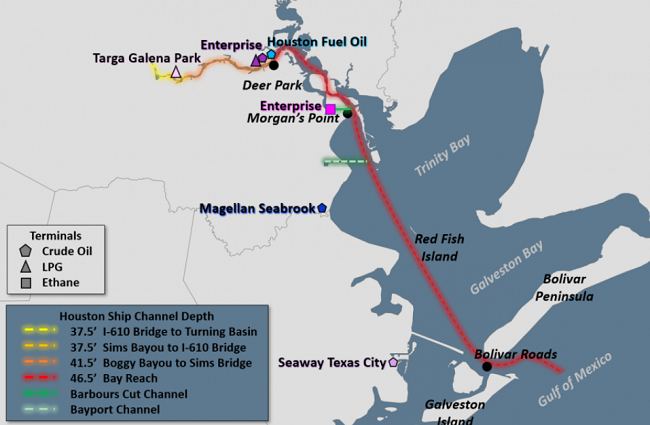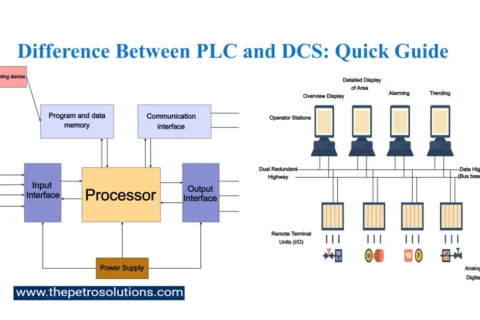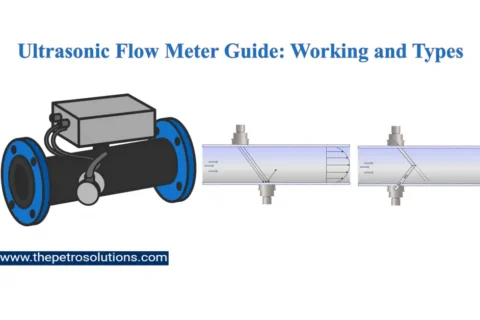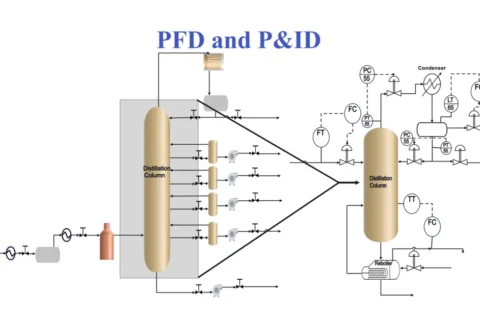The Houston Ship Channel is a long deepwater ship channel or waterway located in Houston, Texas. It is one of the busiest waterways in the United States, handling over 200 million tons of cargo annually. The water channel is 52 miles long, 36 ft (11 m) deep, and has a minimum width of 300 ft (90 m). The Houston Ship Channel is the site of a large number of refineries and other petrochemical plants and is the centre for refined products shipping and spot market trading on the US Gulf Coast.
Houston Ship Channel, connects Houston, Texas, with the Gulf of Mexico, passing through the former Buffalo Bayou and Galveston Bay. The Port of Houston to the Gulf of Mexico is a vital link in the transportation of oil, petroleum products, chemicals, and other goods between the United States and the rest of the world.
Port Houston owns and operates the eight public facilities along the 52-mile Houston Ship Channel, including the area’s largest breakbulk facility and two of the most efficient container terminals in the nation. The Port has served as the strategic leader for this vital waterway for over a century, ensuring the free flow of commerce throughout the region as well as bolstering national and international trade.

History of Houston Ship Channel
The Houston Ship Channel has a long and fascinating history. Here is a brief overview of some of the key events and milestones in the history of the channel:
Early History
The history of the Houston Ship Channel dates back to the early 19th century when steamboats began navigating the shallow Buffalo Bayou, which runs through Houston. These steamboats transported cotton and other goods to and from the Gulf of Mexico. By the 1850s and 1860s, Houston had become a major center for shipping and commerce. However, the shallow and winding Buffalo Bayou made shipping difficult and expensive.
In the late 1800s, various plans were proposed to dredge and deepen Buffalo Bayou, but none were successful. The US Congress authorized the construction of a deepwater port at Galveston, about 50 miles south of Houston, in 1891. However, the devastating hurricane that hit Galveston in 1900 prompted a re-evaluation of plans for a deepwater port at Galveston.
Construction of the Houston Ship Channel
In 1902, the US Congress authorized the construction of a deepwater port at Houston instead of Galveston. Construction of the Houston Ship Channel began in 1909, and the channel was completed and opened to shipping in 1914. The channel was designed to accommodate large ocean-going vessels and provided a more direct and efficient route for shipping between Houston and the Gulf of Mexico.
Expansion and Modernization
The Houston Ship Channel underwent several expansions and improvements over the years to handle the increasing volume of cargo traffic. In the 1920s and 1930s, the channel was expanded and improved to accommodate larger and more numerous ships. During World War II, the channel played a key role in the US war effort and saw significant growth and development in the post-war period.
In the 1960s and 1970s, the channel was expanded and modernized to handle the increasing volume of cargo traffic. In the 1990s and 2000s, the channel continued to grow and adapt to changing economic and environmental conditions, with a focus on improving safety, efficiency, and sustainability.
Why was the Houston Ship Channel was built?
There were several reasons for building the Houston Ship Channel.
- One of the main reasons was to provide a more direct and efficient route for shipping between Houston and the Gulf of Mexico. Prior to the construction of the channel, ships had to navigate the shallow and winding Buffalo Bayou to reach Houston, which made shipping difficult and expensive.
- Another reason for building the channel was to stimulate economic growth in the Houston region. The availability of a deepwater port made it possible for Houston to become a major center for shipping and commerce, and the city experienced rapid growth as a result.
How does the Houston Ship Channel work?
The Houston Ship Channel works by using a system of locks, dams, and dredging to maintain a navigable depth for ships. The channel is divided into several sections, each with its own depth and width specifications. The channel also includes several turning basins and terminal facilities where ships can load and unload cargo. These facilities include container terminals, petrochemical terminals, and bulk cargo terminals.
Ships entering the channel from the Gulf of Mexico must first pass through the Galveston Bay Entrance Channel, which is a 43-mile-long channel that connects the Gulf to Galveston Bay. From there, ships enter the Houston Ship Channel and proceed upstream to the Port of Houston.
Economic Impact of the Houston Ship Canal
As one of the world’s busiest waterways, the Houston Ship Channel is a large and vibrant component of the regional economy. A 2018 study by Martin Associates reports that Houston Ship Channel-related businesses contribute 1,350,695 jobs throughout Texas, up 15 percent compared to a 2014 study. This activity helps generate more than $339 billion in statewide economic value, up nearly 28 percent. Additionally, nearly $5.7 billion in state and local tax revenues are generated by business activities related to the port, up 12.7 percent.





